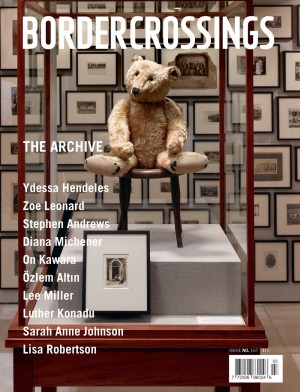Robert Bruce
The Robert Bruce exhibition at the Winnipeg Art Gallery is a retrospective look at an artist who was significant locally during the 1940s through to the 1970s. Bruce was an illustrator, printmaker, painter and art teacher at the University of Manitoba. He died in 1980. It has taken a generation and a sea change in the visual arts to offer up a little “look-see” as to what Bruce was up to during the immediate post-war period, through the heyday of 1950s Abstraction and into the Pop sensibility of liberated form and colour of the 1970s. There must be something in the air in Winnipeg. If not a full-blown retour aux racines, it’s certainly an exploration of the work of those who came of age during Modernism’s halcyon days. Last year, it was the work of Robert Archambeau; next year, Winston Leathers and Bruce Head.
In the case of the Robert Bruce exhibition, the retrospective glance affords a curious satisfaction. The work is familiar enough to be mostly understood, yet strange enough within the history of form for us to consider how corporeality and the figure were able to represent so very much, and how storytelling was once so significant to the operation of the visual. But no melancholic drift here. This is an incredibly upbeat show, due primarily to Bruce’s fondness for the comedic detail and his vital sensibility as a colourist and a designer.

Robert Bruce, Alexander Docks, 1958-60, oil on canvas, 17 x 23”. Collection of the Bruce family. Photo: Ernest Mayer. Courtesy the Winnipeg Art Gallery.
I like historic shows for the certainties that come from arranging an artist’s output in discrete and logical spatializations and for the questions that subsequently emerge. What did domestic pleasure look like in the 1950s? What was corporeality before performance art? How did narrative disappear?
Curator Mary Jo Hughes has provided a coherent and diverse selection of Bruce’s art, from the elegant, purple, glass-topped tables that house Bruce’s small sketches, cartoons, drawings and book illustrations through to the vivacious and textured mono-prints of the 1970s. I am fond of the sketches of the artist at his easel while wife and children carry on. Though he studied lithography in England in the 1930s, the cluster of early paintings shows the young artist working through French influences, from Fauvist scenes to Cézanne’s landscapes. A self-portrait as a bohemian, reminiscent of Fred Varley, shows the assimilation of the École de Paris.
In nearby Portage la Prairie Bruce assumed the task of illustrating the home-front war effort. There, his work centred on soldiers in groups, at work, in training and wrestling with the physical environment of parachutes and paraphernalia. The accompanying catalogue notes that if Bruce had been made an official war artist, his reputation and fame would have been more widespread. I agree. The drawings and gouaches show expressive and active figures in postures that would challenge the most consummate drawing technician. They are more the marvel for the emphasis on the body to carry the affect.

Robert Bruce, On Your Own Time, c.1943, oil on paperboard, 21 x 26”. Collection of the Winnipeg Art Gallery. Photo: Ernest Mayer.
Bruce’s illustrations of modern industry on the rivers were published on late 1950s covers of Maclean’s magazines, after he’d spent time at the Art Students’ League in New York, between 1946 and 1949. He took on freelance illustrations for magazines and later began teaching. Between 1955 and 1976 he taught at the School of Art in Winnipeg and had a career as a commercial artist. One or two of his many murals, made in the 1960s, are still in place. Moving through the retrospective, it becomes apparent that Bruce had the ability to pack more information into the space of a traditional easel painting than any other artist of his time. He achieved this through careful composition, knowledge of the relationships among spatial development, colour and detail, and a disciplined drawing technique based on line. He was an amazing designer with a penchant for drawing the physicality of the active body in robust and comedic ways. As Hughes notes in her essay, he was prone to a certain formal exaggeration.
Later, Bruce’s work shifts from an emphasis on line and composition to one based on colour and texture. Forms loosen up. The transition is made from the space of the real to that of the imagination. As in such works as Mirabelle, 1973, the play is in the striking colour and the organic compositions but the storytelling function of these works never disappears. The Mexican Guitar Player, the portrait of the couple in Lower Invertebrate and the underwater Scuba Divers still maintain a reference to the real. In his later years, Bruce worked hard at showing the mechanics of dissolution and assemblage, particularly through the monoprint, and that battle between the real and the abstract that characterized so much of the work of his generation. It’s an odd pleasure, this recent past, with the rich authenticity of Bruce’s work to give it shape and expression. ■
“The Art of Robert Bruce” is on exhibition at the Winnipeg Art Gallery from June 12 to October 17, 2004.
Amy Karlinsky is a mentor for MAWA. She teaches and writes in Winnipeg.

